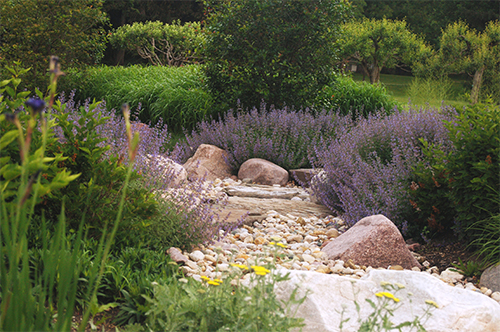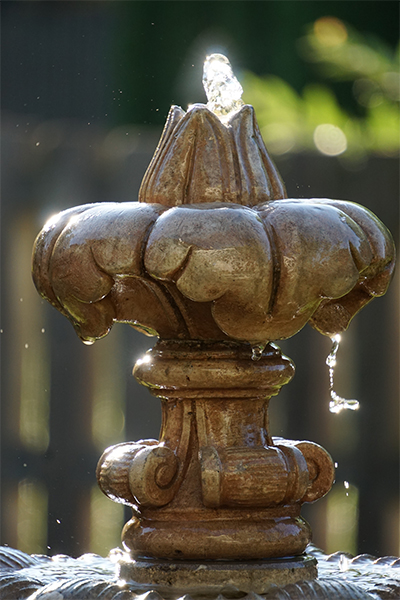Landscape water features can run the gamut from decorative features such as pools, ponds and waterfalls to the more utilitarian like timed sprinkler systems and rain water collection. Whether you’re looking to add a new and delightful layer of sight and sound from the trickle of a fountain or just want to waste less water by installing a smarter sprinkler system, there are many ways to get water-wise with your landscaping. We asked several area professionals for their top tips on incorporating water features into your landscape.
Get to Know Your Landscape
The single most important thing you can do as a homeowner when considering a water feature is to first learn the lay of your land, or find someone who can help you understand it. According to Tony Wasemann, senior landscape designer for Scott Byron and Company, water management is critical. Close proximity to Lake Michigan can make it easy to forget the importance of conservation first. Before a water feature can be installed, knowing how water flows around a property is the first step in remedying drainage issues so that other features can be included without burdening storm drains and municipal retention ponds. Residential building and heavy clay soil also impede water’s movement into our natural aquifers. Creating areas within the landscape that allow water to percolate back into the soil is the best way to help replenish the water supply.

“It’s best to manage water on site and prevent it from leaving the property,” says Wasemann. “Features like rain gardens, retention ponds and dry creek beds really speak to the conservation issue.”
Michael Schmechtig, president of Schmechtig Landscape, agrees.
“Drainage is the first thing we look at and might require redirecting downspouts or manipulating the elevation so water flows away from the home,” says Schmechtig. “Once we do that, we get to the fun part.” It’s All About the View … and Time The fun part always includes a two-for-one approach so the feature can be enjoyed from both inside and outside the home. Fountains and ponds are best admired from several vantage points and a designer will likely want to inspect your landscape from the inside before settling on the right location for the feature.

Things like scale and aesthetic will also play into the decision so that it fits with the overall design of your home and landscape. Maintenance requirements are another big consideration, says Schmechtig. How much work do you want to do? Both ponds and fountains can block unwanted noise, although the first is more labor intensive than the latter. If a waterfall is a must-have, Schmechtig suggests a pondless recirculating waterfall system that sits above a reservoir buried underground.
Water Wisely
Have you ever noticed a business’ or homeowner’s sprinkler system sprinkling in the middle of a downpour? Erin Canterbury, landscape designer for Rocco Fiore and Sons, says many of the company’s clients invest in an irrigation system that always comes equipped with a rain sensor to prevent unnecessary watering. The system is laid out in zones based on the plant material occupying each area. Sprinkler heads set in a grassy area will be calibrated differently than those in a flower bed.
Planters can be added to the irrigation grid and set to their own timers. Water control technology can also be applied to ponds and recirculating features to prevent them from overflowing from rainfall.
“It’s the best way to ensure plant material is properly cared for,” says Canterbury. “Zoning it helps to divide and conquer properly without wasting water.”
Heather Blackmore is a garden field editor for Country Gardens and Outdoor Living magazines. Her work has been featured on Good Morning America as well as in the Chicago Tribune, Chicagoland Gardening and Garden Guide magazines. A lifelong athlete, Heather is a former college rugby and volleyball player and enjoys weightlifting and an active lifestyle. When she’s not working in the garden, she and her husband enjoy attending their daughters’ many band, lacrosse and show choir events. Heather is also a long-time supporter of St. Jude Children’s Research Hospital.

